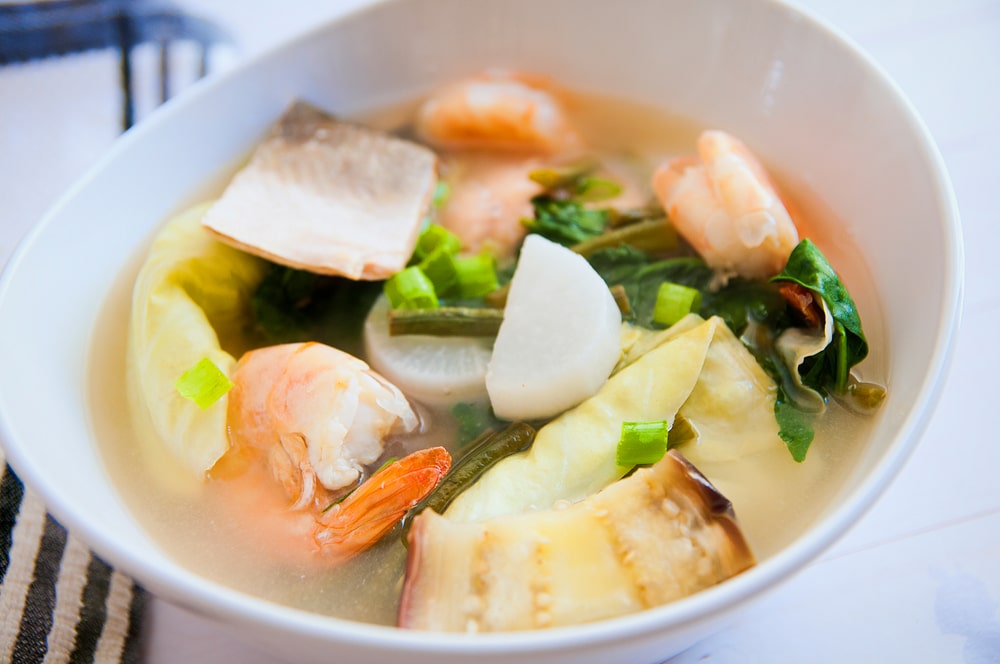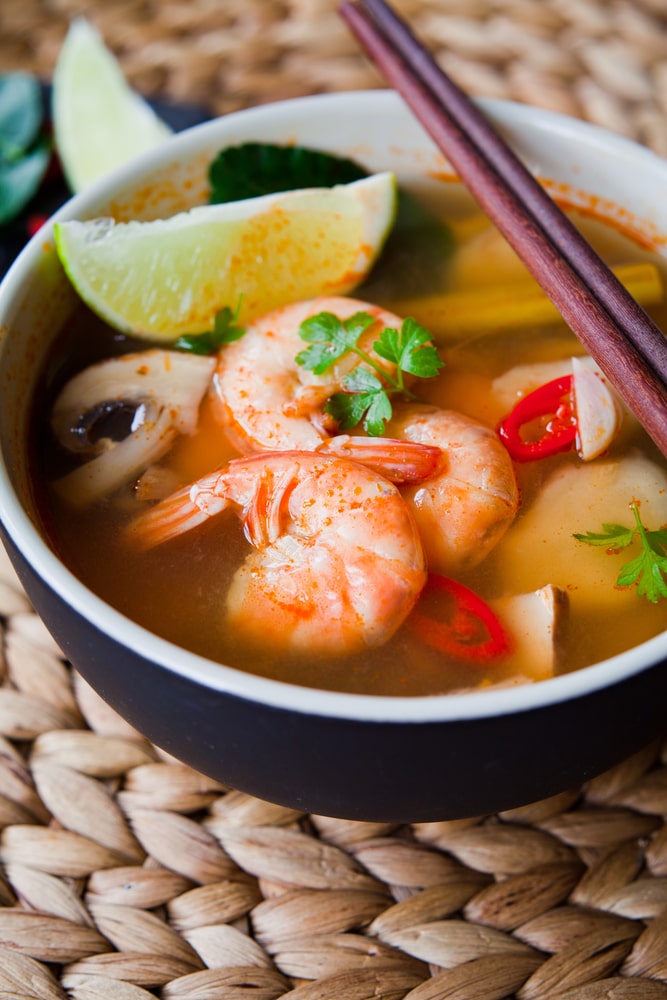Shrimp Sinigang is the ultimate comfort food for those who crave a burst of tangy, savory goodness. This classic Filipino soup brings together succulent shrimp, tender vegetables, and a vibrant tamarind-based broth that’s both refreshing and heartwarming.
What is Shrimp Sinigang?
Sinigang is a popular Filipino soup known for its distinctive sour flavor, typically made using tamarind (sampalok) as the main souring agent. The soup’s foundation includes fresh vegetables like radish (labanos), tomatoes, long green beans (sitaw), and eggplant (talong), all simmered in a flavorful broth.

Tips and Tricks for the Perfect Shrimp Sinigang
Fresh shrimp is key: Using fresh shrimp with shells on adds richness to the broth. You can also toss in the shrimp heads for even more flavor.
Balancing the sourness: If the soup is too sour for your liking, you can add a bit of sugar or more tomatoes to balance the acidity.
Vegetable variations: Feel free to customize the vegetables based on what’s in season or your preference. Other great options include okra, bok choy, or even green papaya.
Sinigang mix for convenience: If you’re pressed for time, tamarind soup mix is a quick and convenient option to get the signature sour flavor without the hassle of boiling fresh tamarind.
Variations of Shrimp Sinigang
Sinigang sa Miso: Add a tablespoon of miso paste to the broth for an extra layer of umami. This works particularly well if you’re using seafood or shrimp, enhancing the overall depth of flavor.
Spicy Shrimp Sinigang: If you love heat, add extra siling labuyo or Thai chilies for a spicy kick.
Shrimp and Pork Sinigang: For a heartier version, you can combine shrimp with pork belly. The richness of the pork complements the lightness of the shrimp, giving the soup a unique twist.

How to Serve Shrimp Sinigang
Shrimp Sinigang is best served hot with a side of steamed white rice. The tangy soup with the tender shrimp and fresh vegetables creates a balanced meal when paired with rice. For a more authentic experience, serve with fish sauce and chili on the side as a dipping sauce for your shrimp.
How to Store and Reheat Shrimp Sinigang
Refrigeration: Store any leftover Shrimp Sinigang in an airtight container and refrigerate for up to 3 days. Keep the shrimp separate if possible, as they can become overcooked when reheated.
Freezing: You can freeze the soup without the shrimp for up to 2 months. Add fresh shrimp when reheating to maintain the texture.
Reheating: When reheating, bring the soup to a gentle simmer and add the shrimp in the last few minutes to prevent them from becoming rubbery.

Recipe FAQs
Can I use frozen shrimp for this recipe?
Yes! You can absolutely use frozen shrimp, but be sure to thaw them properly before adding them to the soup to ensure even cooking. If possible, opt for shrimp with shells on, as they add extra flavor to the broth.
What can I use if I don’t have tamarind?
While tamarind is the traditional souring agent, you can use alternatives like calamansi juice, green mango, or even lemon as a substitute. However, the tamarind gives it that authentic tangy flavor, so it’s worth seeking out if you want a more traditional taste.
How do I prevent shrimp from being overcooked?
Shrimp cook very quickly, typically in about 3-5 minutes. The moment they turn pink and curl slightly, they’re done. Overcooking will make them rubbery, so keep a close eye on them during this step.
Shrimp Sinigang

Shrimp Sinigang is the ultimate comfort food for those who crave a burst of tangy, savory goodness. This classic Filipino soup brings together succulent shrimp, tender vegetables, and a vibrant tamarind-based broth that’s both refreshing and heartwarming.
Ingredients
- 4 cups rice washing (water from rinsing rice)
- 1 medium onion, quartered
- 3 tomatoes, quartered
- 500g fresh shrimp, head, shell, and tail intact
- 1 long green chili, slitted
- 1/2 medium radish, peeled and sliced diagonally
- 1 medium eggplant, sliced diagonally
- 3 okra, sliced diagonally
- 4 sitaw (long beans), cut into 3-inch pieces
- 1 cup kangkong stalks, cut into 3-inch pieces
- 1 cup kangkong leaves
- 1 (20g) pack Sinigang sa Sampalok Mix Original
Instructions
- Prepare the Broth: Pour the rice washing into a pot with the onion and tomatoes. Simmer for 8 minutes to extract flavors.
- Add the Shrimp & Vegetables: Toss in the shrimp, green chili, radish, eggplant, and okra. Let it simmer until the shrimp is pink and fully cooked. (Tip: Devein the shrimp beforehand by carefully removing the black vein along the back.)
- Finish with Greens & Tamarind Mix: Add the sitaw, kangkong stalks, and leaves. Stir in the Sinigang sa Sampalok Mix, adjusting the amount if you prefer a tangier broth. Let everything simmer for a few more minutes until the vegetables are tender.
- Serve & Enjoy: Serve hot with a side of patis (fish sauce) mixed with calamansi juice and steamed rice.
Nutrition Information
Yield
4Serving Size
1Amount Per Serving Calories 594Total Fat 10gSaturated Fat 3gTrans Fat 0gUnsaturated Fat 6gCholesterol 264mgSodium 797mgCarbohydrates 81gFiber 10gSugar 13gProtein 49g
Easy Shrimp Recipes.com, occasionally offers nutritional information for recipes contained on this site. This information is provided as a courtesy and is an estimate only. This information comes from online calculators. Although allchickenrecipes.com attempts to provide accurate nutritional information, these figures are only estimates.
Final Thoughts on Shrimp Sinigang
Shrimp Sinigang is a flavorful and hearty dish that beautifully showcases the best of Filipino cuisine. Whether you’re new to Filipino cooking or a seasoned pro, this dish is easy to prepare and can be tailored to suit your personal tastes. The tanginess from the tamarind, the umami from the shrimp, and the freshness of the vegetables make Shrimp Sinigang a delightful comfort food that you’ll want to make again and again.
Check my other shrimp recipes:

